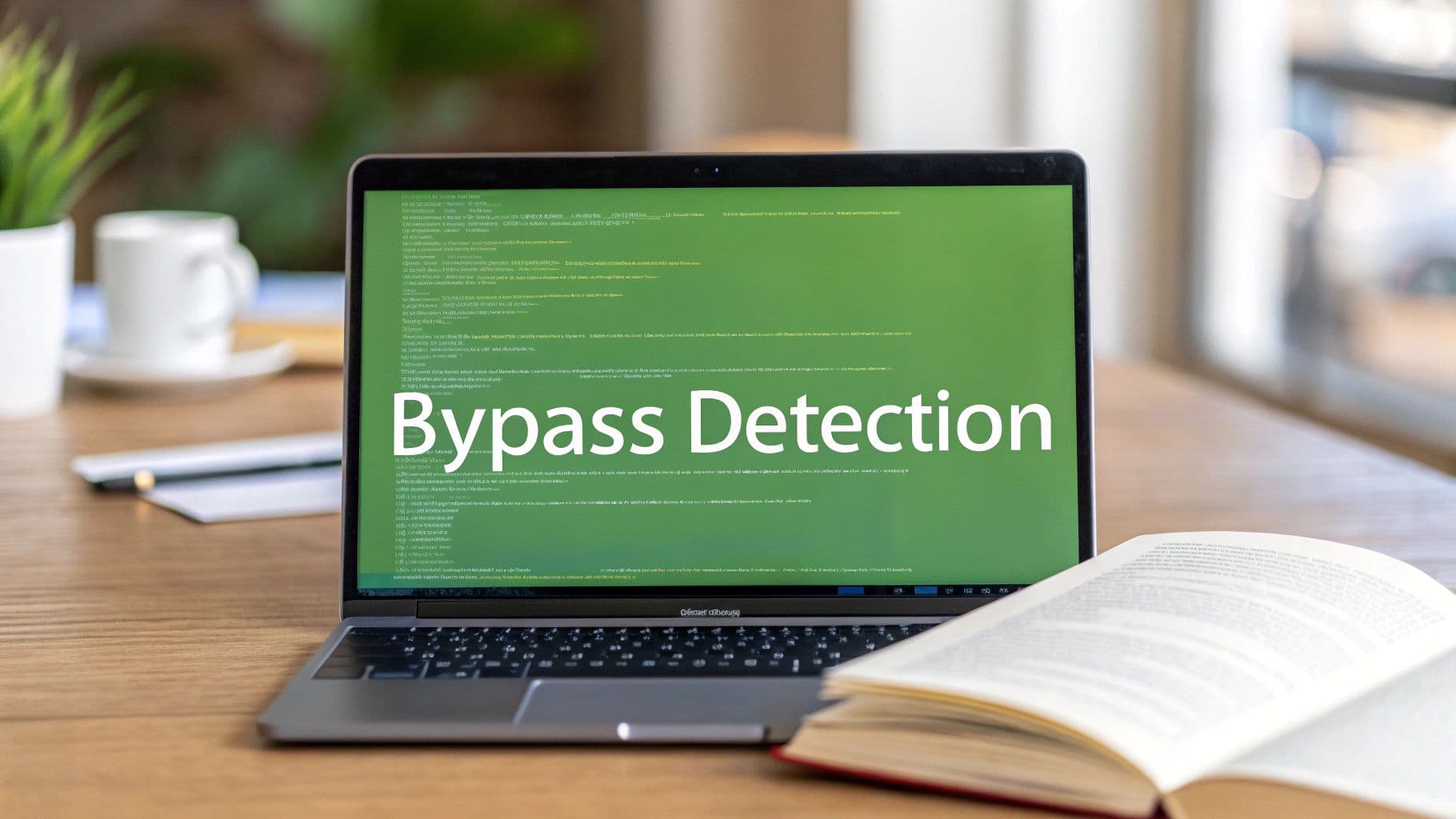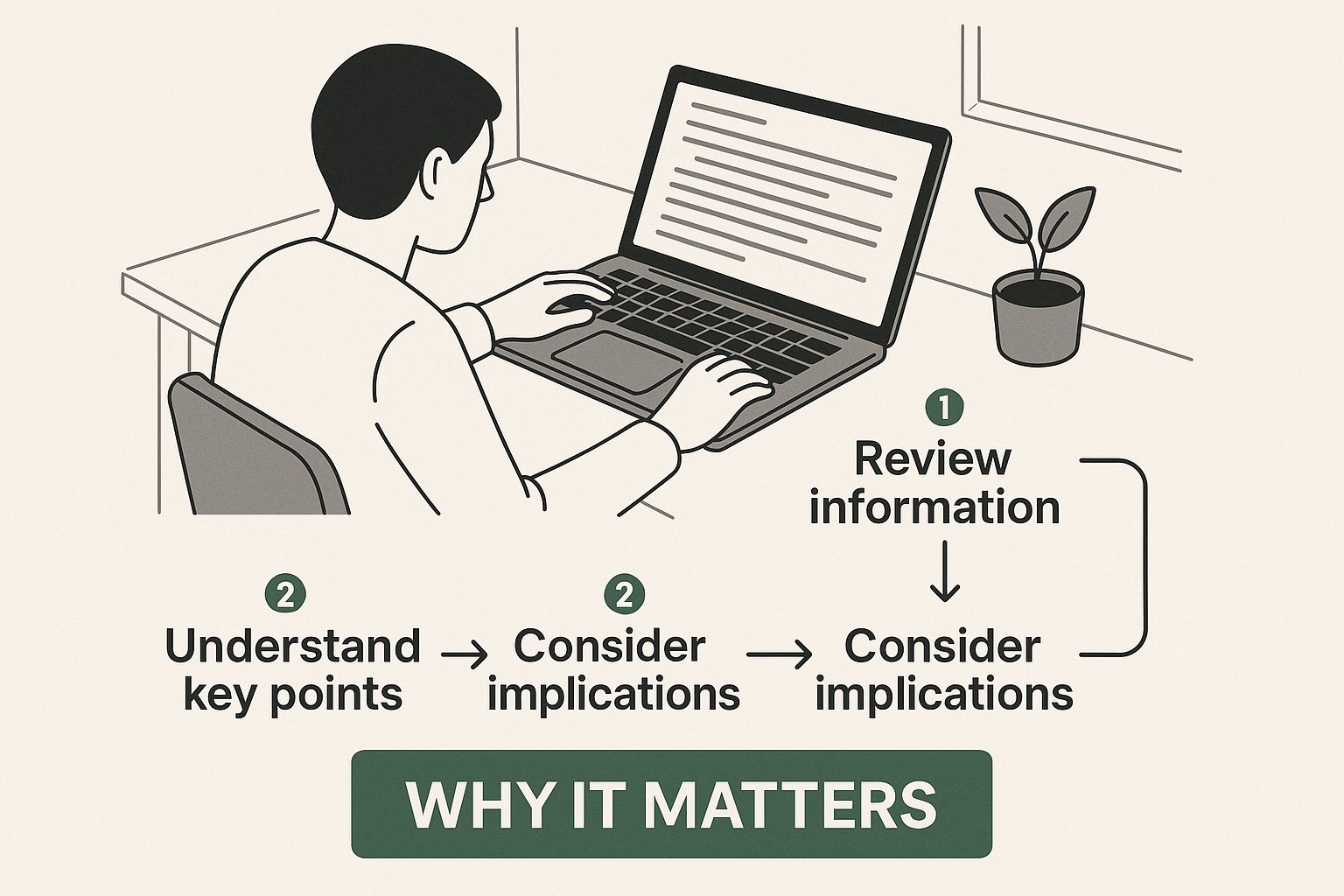
Bypassing AI Detection and Humanizing Your Content
October 10, 2025
Bypassing AI detection is all about refining AI-generated text until it mirrors the natural patterns of human writing, making it unrecognizable to detection software. This isn't just a technical trick; it's an art. It means tweaking sentence structures, adjusting the tone, and swapping out vocabulary to add that crucial natural variability and personal nuance.
The real goal isn't just to fool an algorithm. It's to create high-quality, genuinely engaging content that actually connects with people.
Why Bypassing AI Detection Matters Now
The conversation around bypassing AI detection has really blown up lately, and it's about so much more than just SEO or getting around academic honesty tools.
At its heart, this is about quality and control.
As content creators, marketers, and writers, we lean on AI as a powerful assistant. It’s fantastic for brainstorming and hammering out those initial drafts. But let's be honest, the raw output from an AI often lacks the subtle rhythm and personality that grabs a reader’s attention. It can be sterile, overly formal, and painfully predictable—all the things AI detectors are built to sniff out.
This infographic really nails the key reasons why getting a handle on AI detection has become such a critical skill.

As you can see, the process isn't about deception. It’s about refinement—turning a generic, machine-made draft into a final, polished piece that resonates.
Understanding How AI Detectors Think
AI detectors aren't pulling off some kind of magic trick. They're just algorithms trained on huge mountains of human and AI-written text, looking for specific statistical patterns. They're really good at spotting when things feel too perfect.
To get a better sense of what these tools are scanning for, here’s a quick breakdown of the main signals they track.
A Quick Look at How AI Detectors Work
Understand the main signals AI detectors scan for in your text.
| Metric | What It Measures | Common AI Text Trigger |
|---|---|---|
| Perplexity | How predictable or surprising the text is. | Low perplexity. The text follows a very logical, expected word path. |
| Burstiness | The variation in sentence length and structure. | Low burstiness. Sentences are all roughly the same length. |
| Vocabulary | The range and sophistication of word choice. | Overly complex or repetitive words that feel unnatural. |
| Grammar | Adherence to strict grammatical rules. | Flawless grammar and syntax with zero common human errors. |
As you can see, the very things that make AI text "perfect"—like uniform sentence length and predictable word choice—are also what make it so easy to flag.
The real problem? These detectors can be seriously flawed. If you want to go deeper into their limitations, check out our guide on whether AI detectors actually work.
The Broader Context of AI Deception
Of course, the need for reliable detection is underscored by the rise of some pretty scary stuff. Bypassing detection has become a major concern with the explosion of AI-driven fraud and deepfake technology.
Get this: over 50% of recent fraud incidents involved AI techniques, leading to consumer losses of more than $12.5 billion. The FBI also noted a shocking 33% jump in internet crime losses, highlighting how AI is amplifying financial fraud.
For legitimate creators, the goal is completely different. It’s not about malicious deception but about making sure our AI-assisted work isn't unfairly penalized by imperfect systems. It’s about maintaining creative freedom and producing content that gets judged on its merit, not its origin.
A Practical Guide to Humanizing AI Text

Alright, let's move from theory to actually doing this. Bypassing AI detection isn't about some secret, magic prompt. It’s all about a layered editing process that you bake into your workflow.
Believe it or not, the journey from robotic to relatable content starts way before you touch a single sentence. It begins with how you ask the AI for the initial draft.
Think of your AI as a junior writer who needs crystal-clear direction. If you give it vague instructions, you'll get a bland, generic draft. But if you give it a specific persona or target audience, you'll get something that's already halfway to the finish line, which saves a ton of editing time.
The Initial Prompting Strategy
Getting a better first draft is all about front-loading your instructions. Don't just ask for an article; ask for an article with some personality.
I've found a few prompting techniques that work wonders:
- Specify the Tone: Ask for a "conversational and slightly informal tone," or maybe a "confident but not salesy voice."
- Define the Audience: Try something like, "Write this as if you're explaining a complex topic to a curious high school student."
- Request Varied Structures: "Use a mix of short, punchy sentences and a few longer, more descriptive ones."
This approach gives the AI a framework that starts to mimic real human writing patterns from the get-go. Trust me, it’s way easier to refine a draft that already has some character than it is to inject personality into a sterile block of text. For a more detailed walkthrough, you can explore our full guide on how to humanize AI text for some deeper insights.
Transforming Text From Robotic to Relatable
With a solid first draft in hand, the real humanization begins. This is where you, the human editor, step in to add the nuances and flair that an algorithm just can't replicate. It’s all about breaking down the predictable patterns that AI detectors are trained to spot.
Let’s take a clunky, AI-generated paragraph and rework it together.
Original AI-Generated Text:
"The implementation of artificial intelligence in marketing has resulted in significant enhancements in operational efficiency. This technology facilitates the analysis of vast datasets, thereby enabling businesses to make more informed decisions regarding consumer behavior and campaign optimization. Consequently, return on investment is substantially improved."
This is textbook AI. It’s grammatically flawless but totally lifeless and predictable—a prime candidate for getting flagged by detection tools.
Now, let's apply a few simple but powerful edits to make it undetectable.
- Break Up Uniform Sentence Lengths: The original uses three long, complex sentences. We're going to mix it up with shorter, more direct phrasing.
- Simplify Jargon: Words like "operational efficiency" and "vast datasets" scream "robot." Let's swap them for simpler, more common language.
- Add a Personal, Relatable Touch: Injecting a human perspective makes the content feel more authentic and less like an academic paper.
Humanized Version:
"Using AI in marketing is a complete game-changer for efficiency. It lets you sift through huge amounts of customer data, which means you can finally make smart calls on your campaigns. When you know what people actually want, your ROI naturally gets a major boost."
See the difference? The humanized version is conversational, easier to read, and has a more confident, natural rhythm. By making these small but strategic changes, you effectively erase the AI's statistical fingerprints, creating content that actually connects with readers and sails right past detectors. This kind of hands-on editing is the core of refining AI content.
Advanced Strategies for Evading AI Detection

Alright, let's move past the basics. If you really want your content to sail through the toughest AI detectors, you have to think less about grammar and more about rhythm. It's about capturing the subtle, often imperfect, patterns that make human writing feel… well, human.
This is where the pro-level skills come in. We're talking about adding intentional, human-like quirks that shatter the predictable mold of AI text. It's an art form, really.
Embrace Human Imperfections
One of the fastest ways to get flagged is to be too perfect. AI models are trained on flawless grammar and sentence structure, but real people just don't write that way. So, you need to consciously add back the "flaws" that make writing feel authentic.
Think about these small but powerful adjustments:
- Contractions are your friend. Seriously. "Do not" sounds like a textbook. "Don't" sounds like a person. The same goes for "it's" instead of "it is." This is an instant fix that makes your text feel less robotic.
- Sprinkle in conversational phrases. How often do you start a sentence with "Believe it or not," or "Let's be honest"? Weave these in. They break up the formal tone.
- Don't be afraid of fragments. Sometimes, a short, punchy sentence fragment just works. It adds emphasis. It changes the pace. It's a classic human writing move.
These "imperfections" are like little red herrings for an AI detector. They disrupt the clean, predictable patterns that algorithms are trained to spot, making your content feel far more organic.
The goal isn't to be sloppy. It's to be real. By adding these subtle human touches, you're crafting something that reads less like a machine's output and more like a genuine conversation.
The Power of Tonal Modulation
Have you ever noticed how AI-generated text often sounds… flat? It picks a tone—informative, formal, enthusiastic—and sticks with it from start to finish. Humans just don't do that. We shift our tone constantly.
Tonal modulation is the art of subtly changing your voice to keep the reader locked in. You might start a piece with a confident, authoritative voice, then shift to a more personal, reflective one when sharing a story, and finally get direct and to-the-point when giving instructions.
This kind of variation is incredibly hard for an AI to replicate, which makes it a fantastic tool for bypassing detection. Think of it like a musician changing the tempo; it breathes life and dynamism into the piece. Look for spots in your text where you can inject a different emotional color. Using a top AI brainstorming tool can be a huge help here, as it can spark ideas for more diverse phrasing and tones.
Weaving in Unique Perspectives
Here’s the ultimate tell. The one thing that an AI simply cannot fake is a genuine, original thought. You need to add elements that a machine could never invent on its own, like personal opinions, unique data points you've gathered, or firsthand experiences.
An AI is a master summarizer. It can pull from a universe of existing information, but it can't tell a personal story it never lived.
By weaving in your own insights, you introduce a layer of authenticity that is statistically impossible for an algorithm to generate. This doesn't mean you need to write a long, detailed story. Even a single sentence sharing your personal take on the topic can be the final touch that proves a human was at the helm.
Smart Ways to Use AI Humanizer Tools
Look, manual editing is always going to be the gold standard for bypassing AI detection. But let's be real—sometimes you just don't have the time. You need to get content out the door, and that’s where AI humanizer tools come into play.
Think of them as a skilled assistant, not a magic "one-click" fix. They're built to do the heavy lifting by reworking clunky sentence structures, swapping out those all-too-common AI-ish words, and adding the kind of natural variation that AI detectors are trained to spot and flag.
The Right Tool for the Right Job
Not all humanizers are built the same. Some are perfect for a quick sentence touch-up, while others are designed to handle longer articles. Knowing the difference is key to getting good results without tearing your hair out.
Here’s how I see them:
- Paraphrasing Tools: These are great for tweaking a single sentence or a short paragraph. They're lightning-fast at finding new ways to say something, but they can easily miss the bigger picture and sometimes strip the original meaning or tone right out of your content.
- Style-Focused Grammar Checkers: The more advanced grammar tools are surprisingly useful here. They go beyond just fixing commas and can suggest splitting up long, winding sentences or shifting to a more active voice. These little changes indirectly make your text sound much more human.
- Dedicated AI Humanizers: This is where you find platforms like Natural Write. These tools are built from the ground up for one specific purpose: to analyze text for AI patterns and strategically rewrite it to sound natural and fly under the radar of detectors.
A paraphrasing tool can change the words, but it can't inject a personal story or a unique insight. That part is still on you. The tool just gives you a much better starting point for your final polish.
And it's not just about dedicated rewriters. It's also worth exploring the ecosystem of helpful AI Chrome extensions that can streamline this whole process.
To help you decide what fits your needs, here's a quick comparison of the different tools available for humanizing AI-generated content.
Choosing the Right Humanizing Tool
| Tool Type | Primary Function | Best Used For | Key Limitation |
|---|---|---|---|
| Paraphrasing Tools | Rephrasing sentences and short passages with synonyms. | Quickly rewriting a few sentences to avoid repetition. | Often loses context, tone, and the original meaning. |
| Grammar Checkers | Correcting grammar, spelling, and suggesting style improvements. | Polishing a draft for clarity and readability. | Not designed to address core AI patterns like predictability. |
| Dedicated AI Humanizers | Analyzing and rewriting text to mimic human writing styles. | Converting full AI drafts into natural-sounding content. | Quality can vary; still requires a final human review. |
| Manual Editing | Direct human intervention to rewrite, restructure, and add voice. | High-stakes content where authenticity is critical. | Time-consuming and requires strong writing skills. |
Ultimately, the best approach often involves a combination of these tools, tailored to the specific piece of content and your deadline.
A Practical Workflow That Actually Works
Here's the secret: use these tools as a single step in a multi-step process, never as the final step. Trying to "one-click" your way to perfect, undetectable content is just setting yourself up for disappointment.
Instead, build a smarter workflow.
First, get your initial draft from your AI writer of choice. Then, run that text through a humanizer. The output won't be perfect—don't expect it to be. But what you'll get is a much, much better "second draft" to work from.
This becomes your new starting line.
From here, you can skip the tedious sentence-level restructuring and focus on the high-impact human touches. This is where you add personal stories, simplify complex ideas, and make sure the tone is spot-on. It's a layered strategy that lets you put your creative energy where it matters most.
The Ethics of Making AI Content Undetectable
Let's get one thing straight: knowing how to make AI-generated content undetectable is a powerful skill. And with great power comes great responsibility. This isn't just about outsmarting a tool; it's about navigating the ethical line between using AI as a helpful assistant and using it to deceive. That’s where your integrity comes in.
Think about it this way. A marketer using a tool like Natural Write to clean up a first draft is just being smart and efficient. They’re taking a machine’s raw output and refining it to actually connect with a human audience. In that case, you’re still the author. You’re taking full accountability for the final product's quality and accuracy.
But the ethics get murky fast when the goal is to misrepresent who wrote it. A student who humanizes an AI-generated essay and submits it as their own work? That’s crossing a very clear line into academic dishonesty. It's not about fooling a piece of software; it's about cheating the learning process itself. It’s fraud.
Drawing a Clear Line
So, where do you draw that line? It really comes down to a few core principles of responsible use. The goal isn't to demonize the technology but to own your output completely.
Here are the non-negotiable rules for using these techniques with integrity:
- Maintain Full Accountability: You are the publisher. Period. Every word, every fact, every claim in the final piece is on you, not the AI.
- Fact-Check Everything: AI models are notorious for "hallucinating"—making things up or presenting old information as current. You have to verify every single statistic and claim. It's non-negotiable.
- Disclose When Necessary: In certain contexts, like academia or journalism, transparency is everything. Disclosing that you used AI as an assistant builds trust and upholds ethical standards.
The point is to enhance your own work, not to have AI do it all for you. Think of it as a collaboration where you are always the senior partner, making the final strategic calls.
The Consequences of Misuse
The darker side of this tech shows exactly why ethical use is so critical. Deception is a slippery slope. Recent data revealed a shocking surge in deepfake and AI-generated fraud, with fraud attempts using deepfakes jumping by a staggering 3,000%. This explosion in malicious content puts the responsibility on creators to be good stewards of authenticity.
Ultimately, using AI responsibly is about protecting your own credibility. For a deeper dive into originality, check out our guide on how to avoid plagiarism, which shares principles that apply here too.
Got Questions About Bypassing AI Detection?
Even with the best tools and tricks up your sleeve, you probably have a few nagging questions about getting past AI detectors. This space changes so fast that staying on top of the details is the only way to keep your content feeling authentic and doing its job.
Let’s dig into some of the most common things people ask.
Can AI Humanizer Tools Actually Be Detected?
Yes, and it happens more often than you'd think. A lot of so-called "humanizer" tools make really predictable edits. They'll swap out perfectly good words for clunky synonyms or cram in awkward grammatical errors, thinking it'll fool the system.
The problem is, top-tier detectors like Originality.AI and GPTZero are smart enough to see right through these cheap tricks. Some studies have even shown that while these tools might nudge an AI score down a bit, they completely fall apart against the toughest checks.
It's a bit ironic, really. In an attempt to sound human, many of these tools just end up creating a different kind of robotic text. The output feels forced and unnatural, which completely misses the point. A humanizer is a great place to start, but it's rarely the final word.
Do AI Humanizers Hurt Your SEO?
They absolutely can, and often in a big way. When a humanizer tool butchers your content and makes it hard to read, your website’s user experience tanks. People get confused or frustrated, hit the back button, and your bounce rate shoots up.
Those are all red flags for Google.
Google’s main job is to serve up high-quality, helpful content. If you're using a tool that makes your writing worse just to trick a detector, you're shooting yourself in the foot from an SEO perspective. The focus always needs to be on reader-first quality, not just a score.
Here’s the thing to remember: Google doesn't care if you used AI. It cares if your content is helpful, original, and gives the reader a good experience. Sacrificing readability to trick a detector is a losing game every time.
Is a 100% Human Score Even Possible?
Getting a 100% human score is definitely the goal, but it's not always a perfect science. Some detectors are notorious for false positives, meaning they'll sometimes flag text written by a person as AI-generated.
So, don't obsess over hitting that perfect 100%. Instead, focus on the fundamentals of good, engaging writing. If you apply the right humanization techniques, you can consistently land scores in the high 90s, which is more than enough to fly under the radar.
To get those top-tier scores, really zero in on these three things:
- Mix up your sentences. Use a combination of short, punchy statements and longer, more descriptive ones to create a natural rhythm.
- Get personal. Weave in unique opinions, stories, or little anecdotes that an AI could never come up with on its own.
- Keep it simple. Write like you talk. Avoid overly formal or complex words when a simpler one will do the job better.
At the end of the day, the best way to bypass AI detection is just to write well. When your content is clear, engaging, and genuinely helps the reader, it will naturally have all the hallmarks of human creativity. It'll sail right past the detectors.
The goal isn't just to be undetectable; it's to be undeniably human.
Ready to turn your AI drafts into undetectable, high-quality content? Give Natural Write a try and see how our one-click humanizer can polish your text while keeping your unique voice intact. Visit https://naturalwrite.com to get started for free.


